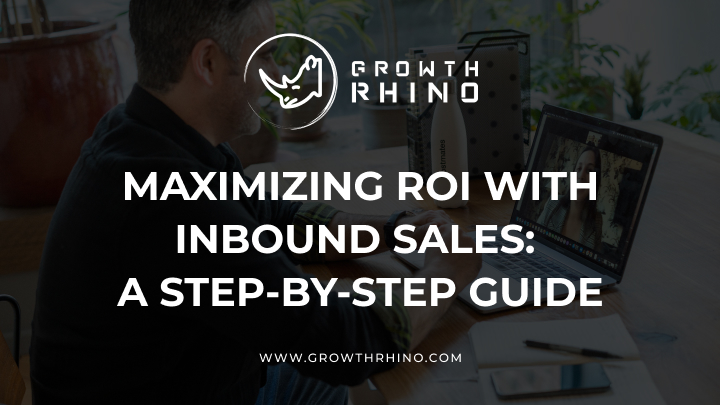
Inbound sale is a customer-centric approach that focuses on attracting and engaging potential customers through valuable and relevant content and interactions. It's all about building trust and rapport with prospects rather than aggressively pushing products or services.
Inbound sales aim to create a seamless and personalized buying experience, leading to increased customer loyalty and high return on investment (ROI).
In this article, we'll provide a step-by-step guide on how to maximize ROI with inbound sales. Read on to find out more!
Step 1: Define your target audience
Before attracting and engaging potential customers, you need to know who you're trying to reach. This means defining your target audience or buyer personas.
A buyer persona is a semi-fictional representation of your ideal customer based on market research and actual data about your existing customers. It includes details about their demographics, behaviors, goals, challenges, and how they make purchasing decisions.
Creating buyer personas can help you understand your target audience's needs and preferences and tailor your inbound sales efforts to better meet those needs. It's essential to take the time to thoroughly research and create accurate buyer personas, as they will serve as the foundation for all of your inbound sales efforts.
Step 2: Create valuable and relevant content
Once you know who you're trying to reach, it's time to start creating content that will attract and engage those potential customers. This could include blog posts, ebooks, whitepapers, infographics, and more.
The key to successful inbound sales content is to provide value to your target audience. This means creating content that addresses their needs, challenges, and goals and provides them with valuable information and insights.
It's also important to ensure that your content is relevant to your target audience and aligned with their interests and preferences. This helps build trust and establish your brand as a thought leader in your industry.

Step 3: Optimize your website for conversions
Your website is often the first point of contact for potential customers, so optimizing it for conversions is crucial. This means making it easy for visitors to find what they're looking for and take the next step, whether filling out a form, signing up for a newsletter, or making a purchase.
There are several ways you can optimize your website for conversions, including:
- Clearly define your value proposition and explain how your products or services solve your target audience's needs and challenges.
- Making it easy for visitors to find information and navigate your site. This can be done by creating a clear website structure and intuitive navigation.
- Including clear and prominent calls-to-action (CTAs). Use a button or a pop-up to encourage visitors to take the next step.
- Creating landing pages specific to each of your products or services and optimized for conversions. This way, visitors will be presented with a tailored experience instead of being sent to your homepage.
- Testing and optimizing your website design and layout to improve usability and increase conversions.
Step 4: Utilize lead nurturing
Lead nurturing is the process of building relationships with potential customers through targeted and personalized communications. It's all about providing value and staying top-of-mind with your prospects until they are ready to purchase.
There are several ways you can nurture leads through the inbound sales process, including:
- Segmenting your leads based on their interests and needs. This will enable you to send them tailored content that speaks directly to their interests and needs.
- Providing targeted and personalized content based on their stage in the sales funnel. This way, you can ensure that the content they receive is relevant, helpful, and valuable.
- Using automation to send targeted emails and other communications, so there's no need to reach out to each lead manually.
- Using social media to engage with leads and build relationships. This is important as it helps establish your brand as a thought leader in your industry.
Lead nurturing can help to keep your brand top-of-mind with potential customers and increase the chances of making a sale.
Step 5: Utilize data and analytics
Data and analytics are crucial to understanding the effectiveness of your inbound sales efforts and identifying areas for improvement. By tracking key metrics such as website traffic, lead generation, and conversion rates, you can better understand what's working and what's not.
Some key metrics to track include:
- Website traffic: This includes the number of visitors to your site and where they are coming from. This can help you understand which channels drive the most traffic and how to optimize those channels for better results.
- Lead generation: This includes the number of leads you're generating from your website and other channels. Tracking this metric can help you understand how effectively your inbound sales efforts attract potential customers.
- Conversion rates: This includes the percentage of website visitors who take the desired action, such as filling out a form or making a purchase. By tracking conversion rates, you can identify areas of your website or sales process that may be causing potential customers to drop off and make adjustments to improve those rates.
- Customer lifetime value (CLV): This measures the total value a customer will bring to your business throughout their relationship with you. By tracking CLV, you can understand the value of your inbound sales efforts and optimize your marketing and sales strategies to maximize ROI.

Step 6: Continuously optimize and improve
Inbound sale is an ongoing process, and optimizing and improving your efforts to maximize ROI continuously is crucial. This means regularly reviewing and analyzing your data and metrics to identify areas for improvement, testing new strategies and tactics, and making adjustments based on what works and what doesn't.
By following these steps and consistently working to optimize and improve your inbound sales efforts, you can create a seamless and personalized buying experience that leads to increased customer loyalty and high ROI.
Conclusions
In conclusion, inbound sales is a customer-centric approach to sales that focuses on attracting and engaging potential customers through valuable and relevant content and interactions. You can maximize ROI with inbound sales by defining your target audience, creating useful and relevant content, optimizing your website for conversions, utilizing lead nurturing and data and analytics, and continuously optimizing and improving your efforts.
So, if you're looking to increase ROI through inbound sales, start by following the above steps and consistently working to improve your efforts. The result will be increased customer loyalty and higher ROI from your sales efforts.
